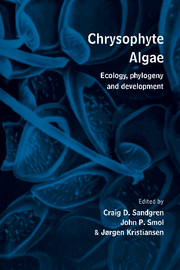Book contents
- Frontmatter
- Contents
- Preface
- List of contributors
- 1 History of chrysophyte research: origin and development of concepts and ideas
- Part I Phylogeny, systematics and evolution
- Part II Development, physiology and nutrition
- Part III Ecology, paleoecology and reproduction
- 9 Chrysophyte blooms in the plankton and neuston of marine and freshwater systems
- 10 Biogeography of chrysophytes in Finnish lakes
- 11 The distribution of chrysophytes along environmental gradients: their use as biological indicators
- 12 The influence of zooplankton herbivory on the biogeography of chrysophyte algae
- 13 Application of chrysophytes to problems in paleoecology
- Part IV Contributed original papers
- Index of scientific names
- Subject index
12 - The influence of zooplankton herbivory on the biogeography of chrysophyte algae
Published online by Cambridge University Press: 05 March 2012
- Frontmatter
- Contents
- Preface
- List of contributors
- 1 History of chrysophyte research: origin and development of concepts and ideas
- Part I Phylogeny, systematics and evolution
- Part II Development, physiology and nutrition
- Part III Ecology, paleoecology and reproduction
- 9 Chrysophyte blooms in the plankton and neuston of marine and freshwater systems
- 10 Biogeography of chrysophytes in Finnish lakes
- 11 The distribution of chrysophytes along environmental gradients: their use as biological indicators
- 12 The influence of zooplankton herbivory on the biogeography of chrysophyte algae
- 13 Application of chrysophytes to problems in paleoecology
- Part IV Contributed original papers
- Index of scientific names
- Subject index
Summary
Introduction
Chrysophyte algae: ecology and biogeographic distribution
The great majority of planktonic chrysophytes (algal class Chrysophyceae sensu Hibberd 1976; incl. Synurophyceae, sensu Andersen 1987) are rather delicate, golden-colored flagellates. Both unicellular and colonial chrysomonads are common in lake plankton and they exhibit three distinct types of cell coverings: ‘naked’ cells (cell membrane only), cells in expanded organic loricas, and cells covered with ornamented siliceous scales and/or bristles. This morphological diversity may affect their palatability for herbivores or may increase the effective diameter of chrysophyte cells as zooplankton ‘food particles’. Chrysophytes range in natural particle size from a few micrometers to several hundred micrometers in diameter; larger colonies are mostly spherical (Synura, JJroglena, Chrysosphaerella), but some are dendroid (Dinobryon) or linear (Chrysidiastrum). Chrysophyte algae demonstrate seasonally restricted population cycles in lakes (Sandgren 1988); they produce siliceous resting cysts and probably recruit annually from sedimentary ‘seed’ populations of these cysts (Sandgren 1991).
Chrysophytes are among the most poorly studied freshwater phytoplankton with regard to their nutrition, physiology and ecology. Those genera of interest here are phototrophs, but many also have a facultative or obligate capacity for supplementary phagotrophic and osmotrophic feeding (Sanders 1991; reviewed in Sandgren 1988; also see Holen & Boraas, this volume). Chrysophyte algae are frequently biomass dominants, together with other algal flagellates, in the myriad of small, softwater, and largely oligotrophic lakes of the north-temperate regions of North America and Scandinavia (as summarized in Sandgren 1988).
- Type
- Chapter
- Information
- Chrysophyte AlgaeEcology, Phylogeny and Development, pp. 269 - 302Publisher: Cambridge University PressPrint publication year: 1995
- 7
- Cited by



